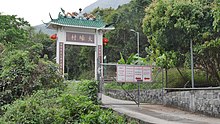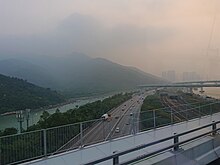






Tai Ho Wan or Tai Ho Bay (Chinese: 大蠔灣; Cantonese Yale: daaih hòh wāan; lit. 'big oyster bay', also 大濠灣; 'big inlet bay') is a bay on the north shore of Lantau Island in the New Territories of Hong Kong. It is located west of Siu Ho Wan, and northeast of Tung Chung and Kei Tau Kok [yue]. The surrounding land was originally planned to be part of the North Lantau New Town scope, but there is a current slowdown in its plans because of the lack in population growth and environmental groups opposed to the next in abeyance.
Tai Ho was originally a rural area. To the northern part there is a shoal extend and to the southern part is the foot of Lin Fa Shan. Slopes are covered with grassland and shrub forests. There are monsoonal nature of swamps, as well as a stream named Tai Ho Stream which flows into the Tai Ho Bay.
Villages
Villages in the area include Pak Mong, Ngau Kwu Long, Tai Ho Village aka. Tai Ho Tsuen (大蠔村), Tai Ho New Village aka. Tai Ho San Tsuen (大蠔新村) and Tin Liu (田寮). At the time of the 2011 Census, the population of the area was about 150 persons.
Pak Mong, Ngau Kwu Long and Tai Ho are recognized villages under the New Territories Small House Policy. The three villages historically formed the San Heung (三鄉) community.
History
In 1989, the British Hong Kong Government announced that the Airport Core Programme, which includes the north through the Tai Ho, North Lantau Highway, and the development of Tai Ho into new towns. The plans for the Tung Chung line was released at this time which also called for the construction of a Tai Ho station. However, in the late 1990s, due to the slow down in the development of Tung Chung, the expected slow down in population growth, coupled with environmental concerns that the development of Tai Ho will affect the local environment and ecology, large-scale construction is still under review.
A part of the bay and a stream flowing into it were designated as a Site of Special Scientific Interest in 1999.
Private property developers Sun Hung Kai and Swire Properties have stated in 2000 having started purchasing land in the area "many years ago". It was reported in 2014 that about 70 per cent of private land in the Tai Ho area had been sold to developers, the majority of it being owned by Sun Hung Kai Properties. Villagers have protested against some aspects of the environmental protection plans of the area, which might constrain their right to farm and build small houses. Protests involved the blocking of private roads and footpaths leading to the bay, as well as the destruction of mangrove in 2014.
Nature
Tai Ho Stream (大蠔河) runs past Tin Liu, Tai Ho San Tsuen and Ngau Kwu Long to Tai Ho Wan. It has been reported as the stream supporting the greatest diversity of freshwater fish and brackish water fish in Hong Kong, with 68 species recorded. In 1999, the Hong Kong Government designated Tai Ho Stream as the 63rd Site of Special Scientific Interest (SSSI) due to the discovery of the Ayu (Plecoglossus altivelis) in the river, which cannot be found anywhere in the world except for waters in Hokkaidō, and Hong Kong. Other freshwater fish species recorded include Anguilla marmorata, A. japonica, Awaous melanocephalus and Pisodonophis boro. The SSSI covers an area of about 5 hectares that includes Tai Ho Stream and several tributaries, as well as the southern end of Tai Ho Bay, featuring mangrove and seagrass.
Other species that have been recorded in the area include Horseshoe crabs, that are commonly found in the Halophila beccarii seagrass beds of Tai Ho Wan, tokay gecko (Gekko gecko), rare or uncommon butterflies including red lacewing (Cethosia biblis) and amphibian species including Romer's tree frog (Liuixalus romeri) and short-legged toad (Megophrys brachykolos).
Infrastructure
Tai Ho Wan was partially reclaimed in the 1990s. It is now crossed by the North Lantau Highway, Cheung Tung Road, the Airport Express and the Tung Chung line of the MTR. The land reclamation is also the site of the interchanges between North Lantau Highway and Shun Long Road (順朗路), part of the Tuen Mun–Chek Lap Kok Link.
Other features
A site in Pak Mong and a site in Tai Ho Village have been listed as a Sites of Archaeological Interest.
The area features three graded historic structures: the watchtower of Pak Mong (Grade II), the watchtower of Tai Ho (Grade III) and the Entrance Gate of Pak Mong (Grade III).
References
- "Minutes of 1054th Meeting of the Town Planning Board held on 14.3.2014. Agenda Item 7. Consideration of the Draft Tai Ho Development Permission Area Plan No. DPA/I-TH/E" (PDF). www.info.gov.hk. Town Planning Board. 14 March 2014. p. 10.
- "List of Recognized Villages under the New Territories Small House Policy" (PDF). Lands Department. September 2009.
- ^ "Site of Special Scientific Interest - Tai Ho Stream, Lantau Island" (PDF). Planning Department. 30 September 1992.
- "Follow-up paper - powerpoint materials on North Lantau Development from the Sun Hung Kai & Swire Properties Ltd. [CB(1)1712/99-00(02)" (PDF). Legislative Council of Hong Kong. Panel on Planning, Lands & Works. 18 May 2000.
- ^ Kao, Ernest (4 August 2014). "No entry: villagers bar access to Lantau bay over environmental 'conspiracy'". South China Morning Post.
- Kao, Ernest (25 August 2014). "Villagers in Lantau destroy mangrove in bid to halt 'protected status' plan". South China Morning Post.
- Kao, Ernest; Cheung, Chi-fai (26 August 2014). "Planners to probe villagers' felling of mangrove". South China Morning Post.
- ^ "Freshwater Fish of Hong Kong". Agriculture, Fisheries and Conservation Department. Retrieved 15 August 2023.
- "Register of Sites of Special Scientific Interest (SSSIs)". Planning Department.
- EcoNavi (December 2005), 綠色香港──生態欣賞與認識 (in Chinese), Hong Kong: Arcadia Publishing, ISBN 978-962-8884-44-5
- Fong, Terence Ching-wai. "Tai Ho Wan: breeding and nursery ground of horseshoe crabs". HKU School of Biological Sciences.
- "TPB Paper No. 10186 for Consideration by the Town Planning Board on 7.10.2016. Draft Tai Ho Outline Zoning Plan No. S/I-TH/B. Preliminary Consideration of a New Plan" (PDF). www.info.gov.hk. Town Planning Board. 7 October 2016.
- Antiquities and Monuments Office. List of Sites of Archaeological Interest in Hong Kong
- Antiquities Advisory Board. List of the 1,444 Historic Buildings with Assessment Results
Further reading
- Hamilton, Eric; Schofield, Walter; Peplow, S. H.; Tsui, Paul; Coates, Austin; Hayes, James (2010). "Chapter 3. Lantao Island". In Strickland, John (ed.). Southern District Officer Reports: Islands and Villages in Rural Hong Kong, 1910-60. Hong Kong University Press. pp. 82–85. ISBN 9789888028382.
- Williams, Martin (23 November 2012). "History of Pak Mong on Lantau". www.hkoutdoors.com. Archived from the original on 2 December 2021.
- "TPB Paper No. 10186 for Consideration by the Town Planning Board on 7.10.2016. Draft Tai Ho Outline Zoning Plan No. S/I-TH/B. Preliminary Consideration of a New Plan" (PDF). www.info.gov.hk. Town Planning Board. 7 October 2016.
- "Draft Tai Ho Outline Zoning Plan No. S/I-TH/1" (PDF). www.districtcouncils.gov.hk. Town Planning Board. March 2017.
External links
- Aerial photograph of Tai Ho Bay in 1992
- Map of the Tai Ho Outline Zoning Plan S/I-TH/1 as exhibited on March 24, 2017
- Pictures of Tai Ho Wan
| Lantau Island | |||||||||
|---|---|---|---|---|---|---|---|---|---|
| Divided between Islands District and Tsuen Wan District | |||||||||
| Areas | |||||||||
| Landmarks |
| ||||||||
| Transport |
| ||||||||
| Education | |||||||||
| This list is incomplete. Hong Kong SkyCity (including AsiaWorld–Expo) and Hong Kong International Airport (Template) are on adjacent Chek Lap Kok though have addresses for Lantau Island. | |||||||||
22°17′57″N 113°58′42″E / 22.299266°N 113.978260°E / 22.299266; 113.978260
Categories: